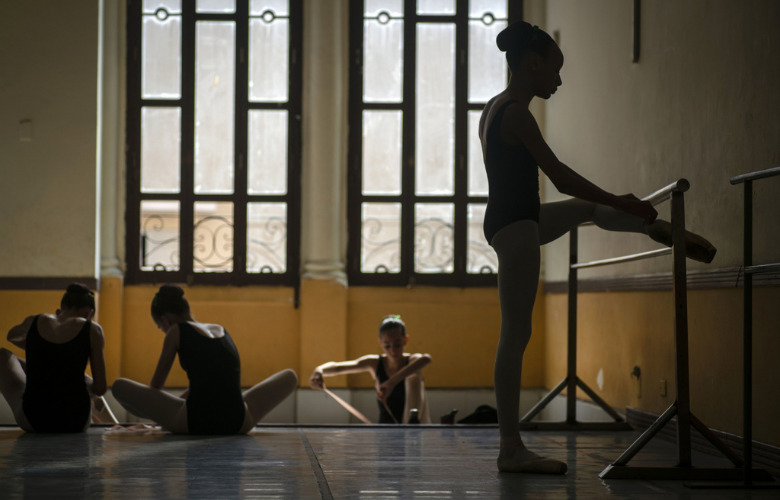
Alicia Alonso was a Cuban prima ballerina and choreographer whose company became the Ballet Nacional de Cuba in 1955. A ballerina of unusual range and power, she continued to dance into her 80ies despite chronic vision problems. Alonso is best known for her portrayals of Giselle and the ballet version of Carmen.
Alicia Alonso was born in Cuba in December of 1920. When she was 17 years old, Alonso fell in love with the young dancer and political activist, Fernando Alonso. They decided to leave Cuba together to begin a new life in New York City.
At 19 years old, Alonso gave birth to her daughter Laura. Young motherhood did not slow her down. Before landing spots on a ballet company roster, Fernando and Alicia danced in two briefly-running Broadway musicals, Great Lady (1938) and Stars in Your Eyes (1939).
Around the same time, however, she began to experience vision problems. She went back to Cuba where major surgery for a detached retina left her bedridden for a full year. But she was a fighter and wasn’t about to let these medical issues take ballet away from her.
While recuperating she practiced Ballet with her reduced eyesight. Using her fingers to help her navigate. She never gave up. In 1943, finally, her resilience was rewarded, and her doctors cleared her to return to New York City and to the American Ballet Theatre.
Unfortunately, from then onwards, vision problems became chronic for her.
One night in 1943, Alonso stepped in for an ill Alicia Markova, capturing audiences with her technical prowess and emotional authenticity in the role of Giselle — that night and many nights thereafter.
The part would come to define her career, and she would perform it for American Ballet Theatre, Ballet Russes de Monte Carlo and National Ballet of Cuba for decades to come. She would also dance leading roles in de Mille’s Fall River Legend (1948) Fokine’s Les Sylphides, and Undertow (1945). A top honor was Balanchine choreographing Theme and Variations (1947) on her and her long-time partner Igor Youskevitch.
Jack Anderson of The New York Times describes how, with Ballet Theatre folding, Alonso and her husband returned to Cuba.
In 1948, they founded the Ballet Alicia Alonso. Then, two years later, they founded the Ballet School of Alicia Alonso. But financial struggles led them to have to close the school in 1956.
All the while, Alicia Alonso continued to dance internationally.
In 1956, the newly ascendant Cuban revolutionary Fidel Castro granted Alonso 200,000 USD to revive the company and school, under the new name The National Ballet of Cuba. “But it better be great dancing,” he said to her and Fernando.
It wasn’t long before Alicia Alonso was a national icon, lauded all over the island and placed on postage stamps (Anderson, Jack, “Alicia Alonso, Star of Cuba’s National Ballet, Dies at 98”, The New York Times, 17 October 2019). The school would go on to train dancers who would be leaders in the art form all over the world.
Her dance partner Youskevitch learned how to ensure he was always in the exact correct position relative to Ms. Alonso so she would not have to rely on sight to dance with him. A wire was often placed at the front of the stage to prevent her from falling into the orchestra pit, and lights were strategically placed around the stage so she could determine where she was by their relative brightness.
When she was almost completely blind, she was unable to see her way onto the stage or off of it. Her partners would whisper instructions to her as she moved. Still, Alonso never gave up and neither let her vision problems nor encroaching old age limit anything she did.
In an interview with the New York Times she once stated, “You don’t have to think about how old you are, or what physical limitations you have… you have to think about how many things you want to do, and how to do it, and keep on doing it.”
Alicia Alonso gave her final performance in 1995, at age 85, when she danced The Butterfly, a piece she had choreographed.
She died at age 98, in October of 2019, and will forever be remembered as one of the greatest prima ballerinas of all time.
Claire Bournet and ‘Trafic de Styles’ in Paris – an Interview
Guilherme Botelho – Dance and the Quest for Meaning


Liam Klenk was born in Central Europe and has since lived on four continents. Liam has always been engaged in creative pursuits, ranging from photography and graphic design, to writing short stories and poetry, to working in theatre and shows. In 2016, Liam published his first book and memoir, 'Paralian'.
Read Full Profile© 2021 TheatreArtLife. All rights reserved.

Thank you so much for reading, but you have now reached your free article limit for this month.
Our contributors are currently writing more articles for you to enjoy.
To keep reading, all you have to do is become a subscriber and then you can read unlimited articles anytime.
Your investment will help us continue to ignite connections across the globe in live entertainment and build this community for industry professionals.